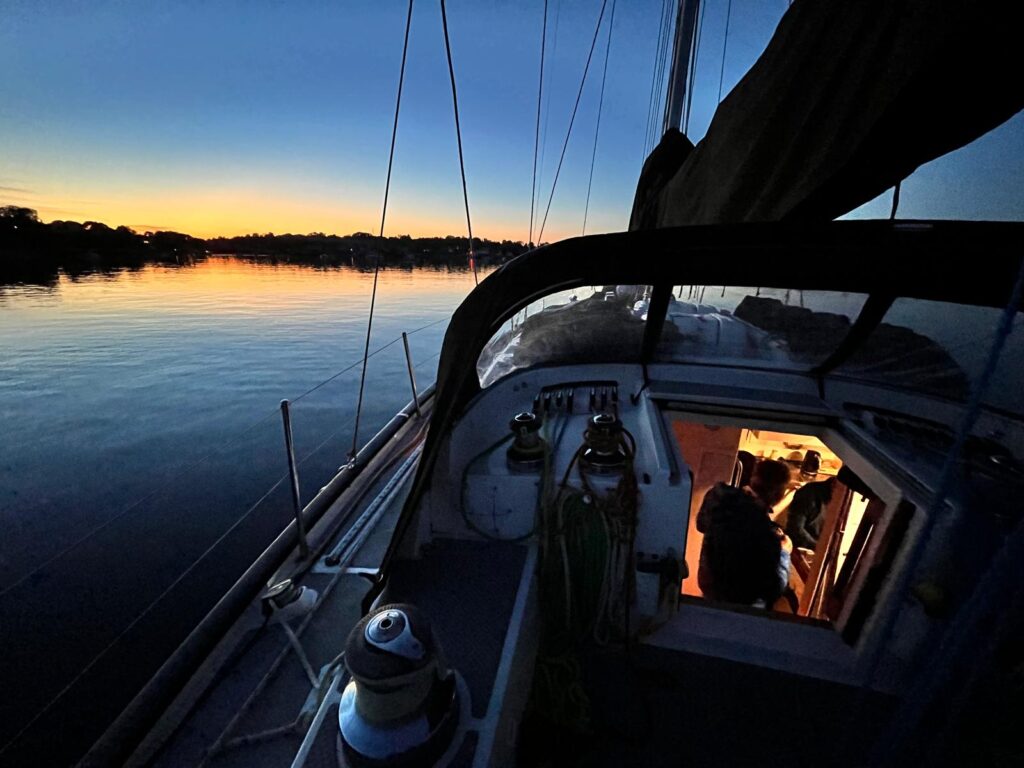Blog 4: St John’s to mid-Atlantic
While I sit in the saloon in my dampened Salopettes, sipping on a freshly made cup of tea and tapping away on my laptop, there is no shortage of happenings around me. The galley is a hive of activity, with the remanence of the scrambled egg breakfast being cleared away and preparations already starting for the lunchtime rush. The whiff of onions over my left shoulder makes me tear up, let alone Roland, who had meticulously diced onions for twelve people before I started writing this blog. Jack sits across from me while he glues back together the soles of his Dubarry boots, using a pair of mole grips as a vice. Stewart, to my right, is absorbed in his daily journaling. Still, not so much that he can’t crack the occasional pun on the current goings-on. As the morning progresses, the saloon gets busier with traffic as we approach Gull Island. Foulies, boots and lifejackets are put on as most of the crew head up on deck to catch a glimpse of the plethora of birds surrounding the rigging. Hundreds of puffins, laughing gulls and common murres clutter the cliff edge as they fish, play and squawk. Unfortunately, no moment can do any justice to a camera.
Now I’ve set the current scene, and I hope I will cast us back to where we last left off – Louisbourg. After weighing anchor from Louisbourg, there was not much to report that day, which now, looking back on, I am most thankful for as the following days were jam-packed with activity, and there is only so much I can fit into these ramblings. At 4 am on Tuesday, Simon handed over the watch to me. Unbeknownst to me at this time, this was set out to be one of the best sunrise watches I’ve ever experienced, and I’ve experienced a few. The sky was starting to brighten as the wind picked up to a steady 15kts off the beam, a most welcome sight after a long night of motoring. Watch C, also known as ‘The Squaddies’, hoisted the Yankee one, eased out the main sail, and cruised comfortably at 7kts, perfectly on course. As the day went on, the sun rose in the still morning sky, free of fog for a change, and I made my way down to the galley to make the off-going watch beans on toast – a new culinary experience for some. While stirring the beans on the gimbaled stove, Jack shouts down the companionway,” WHALES!”. I often ignore these calls as we have many wildlife sightings, but rarely does it come to fruition enough for me to don my life jacket and head up on deck. However, this time was different. After Jack shouts for a third time, I switch off the gas and grab my life jacket. As soon as I popped my head out of the hatch, I caught a glimpse of the humpback’s tail. With what looked like three humpback whales dancing around the boat, I ran up to the bow, often the best place to spot sea creatures, and waited a few seconds. Just as I was about to give up, a giant humpback whale immersed from the deep blue water right up towards the bow sprit a mere 3ft from my face as the bow dipped down a wave. Stunned at what I saw, I froze a second before my next thought turned to ‘this thing is gonna wallop into the boat!’ I turned my head back to the cockpit, ready to call for the helm to bear away, when the whale effortlessly rotated and slid under the bow as if that was the plan all along. We spent the rest of the morning validating our sightings from the pictures in the guidebook, completely in awe of what we just experienced.
Later that day, we decided to divert our course again and head to Branch Cove instead of St Lawrence. As we approached the bay, we passed the Hare’s Ears rock, slightly subjective in my eyes. Still, we humoured the concept and motored into a secluded anchorage, or at least that’s what we thought. A few minutes later, as I was titivating with the anchor chain and snubber, I heard a buzzing sound from above my head. Most of the crew had stumbled out of bed and joined me in the confusion about where this noise was coming from. As we looked around the rigging, we noticed a drone flying so close to the boat that it might as well come inside for a tour. Slightly confused and somewhat displeased, we gave the drone an obligatory wave as it circled Bluejay before returning to Branch—a strange welcome from what looked like a small, desolate town.
We were fuelled by our need for fresh milk and bread and maybe deep down to find the drone’s owner, so we inflated the dinghy and headed ashore. As we meandered the dinghy through the harbour entrance, we were greeted by what could only be described as two intimidating and slightly menacing-looking dirt bike riders. As we headed further into the harbour, they revved up their engines. They paralleled our course on land, following us round the water. Somewhat daunted but determined to get the milk, we docked the dinghy alongside a fishing boat and stepped ashore. Within two minutes of being on Newfoundland soil, we were welcomed by Chris, later found out to be the drone flyer, and his two sweet daughters – the menacing dirt bike riders. We learned all about the small town of Branch; it didn’t take long. Twenty-six children are at the local school, a mini market that sells more alcohol than actual food, and the only place where you can get a phone signal is at the top of the hill by the church. As the day went on, we were welcomed with open arms, and every local knew there was a new boat in town. Some even welcomed us into their homes, offering hot showers and cake, which we gladly accepted. We culminated the evening onboard with pecan pie, a bottle of shiraz and a screening of Master and Commander in the saloon.
The next morning, we started the day by weighing anchors and heading to Trapassey, a narrow inlet on the Av alon Peninsula. As we motored out of the bay, I joined Stewart and Jack on the foredeck for an impromptu yoga class by Debs. Although lifejackets restricted us and were somewhat spatially compromised, it didn’t stop us from stretching our aching limbs and giggling in the process. We vowed to keep up the practice, but the foredeck has not been entirely stable. Our arrival in Trapassey was similar to most we’ve experienced in Canada – foggy, slightly damp, but incredibly welcoming. After spending the afternoon exploring and sampling Jack’s homemade lemon drizzle cake, we headed to the only restaurant in town, the Avalon Inn. After conversing with the locals, we discovered that just twenty minutes down the road was Saint Vincent Cove, a famous whale hotspot at that time of year. Within an hour of asking around, the waitress decided she would lend us her car keys so we could go and see the whales the following morning, as long as one of us drove her home after her shift ended that evening. Another hour after that, excited at the prospect of us exploring their town, she decided to come along as our tour guide and show us the Trapassey highlights. 6 am came around. Carole-Anne and her sister-in-law were ready and waiting to squeeze all twelve of us into their cars. The two smallest Debs and I took the boot, which provided a lovely panoramic view, and the rest squeezed in where necessary. The next few hours were spent whale watching on the beach, exploring St Shotts and cruising the roads looking for caribou. I cannot say enough kind words about the folk of Trapassey.
Once the deck was prepared, we waved goodbye to our newfound friends of Trapassey and headed 50nm up the coast to Fermeuse. This would be our last night on anchor before making our way to St John’s to start preparations for our next big adventure – crossing the North Atlantic.
Blog 3: Mahone Bay to Louisbourg, Nova Scotia
Although it’s been nearly a week since we weighed anchor from Mahone Bay, I would like to continue from where I left the last blog, sipping on a travel-size bottle of Merlot as the sun went down over the cockpit; what could be better? A full-size bottle, I hear you cry. As the evening continued, the crew parted ways, some dropping into the local watering hole. In contrast, the others chose an evening onboard, reading, listening to music and journaling. Journaling is a viral activity aboard Bluejay. A trip like this gives you time to ponder your thoughts and feelings, or like Stewart, your profession as a film editor and screenwriter naturally steer you in that direction. Alongside Stewart in the forward accommodation, we have Matt, a construction coordinator; in layman’s terms, he manages set designs within the TV and film biz. The forward accommodation has now aptly been christened “Hollywood”, with Lesley from North Ayrshire thrilled to share her living quarters with the two LA stars; now they can understand her accent.
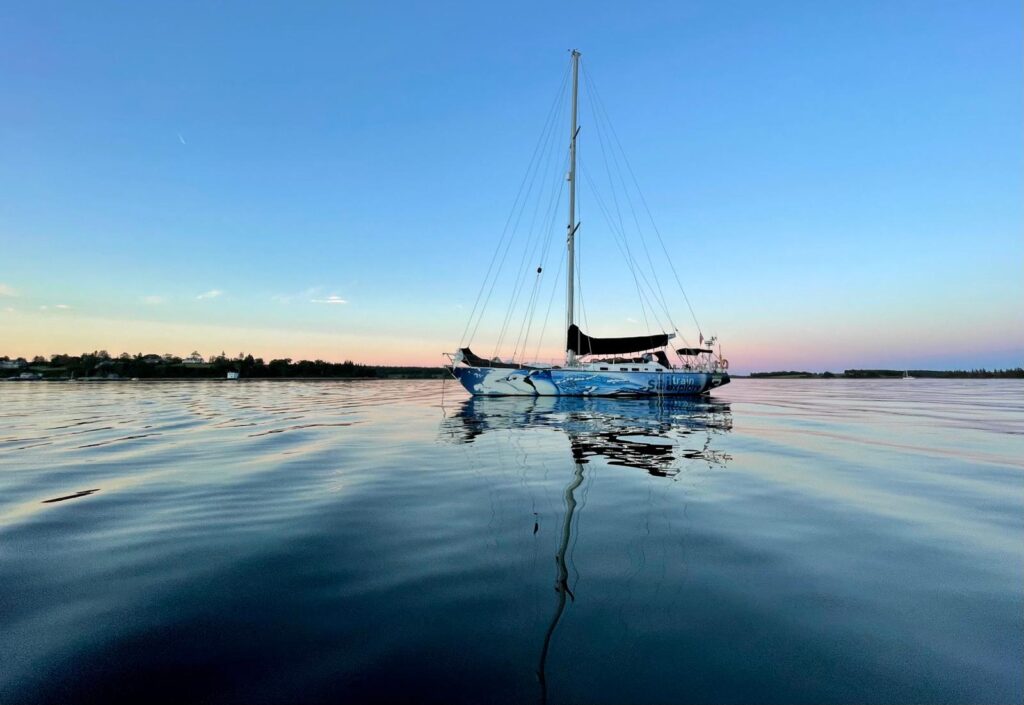
After learning the local colour and sampling some local beers, I took the four crew ashore back to Bluejay. Upon our return, we found a most impressive set-up in the saloon to stream the evening’s presidential debate. Armed with enthusiasm and determination, the crew had carefully perched an iPad on the pressure cooker, which was then placed on top of our tallest cooking pan on the saloon sofa. Wired up to the Bluetooth speaker, which swung from the fruit nets above our heads, we cosied up in the saloon to watch the evening’s discussion, this time sampling the Bluenose rum purchased back in Lunenburg. A stiff drink was needed for this screening. We also toasted our youngest crew member, Jack, who received a rather impressive set of exam results from his first year at Southampton University that evening. He is studying marine engineering, so we hope he can design us a boat on the quick if anything should happen to this one.
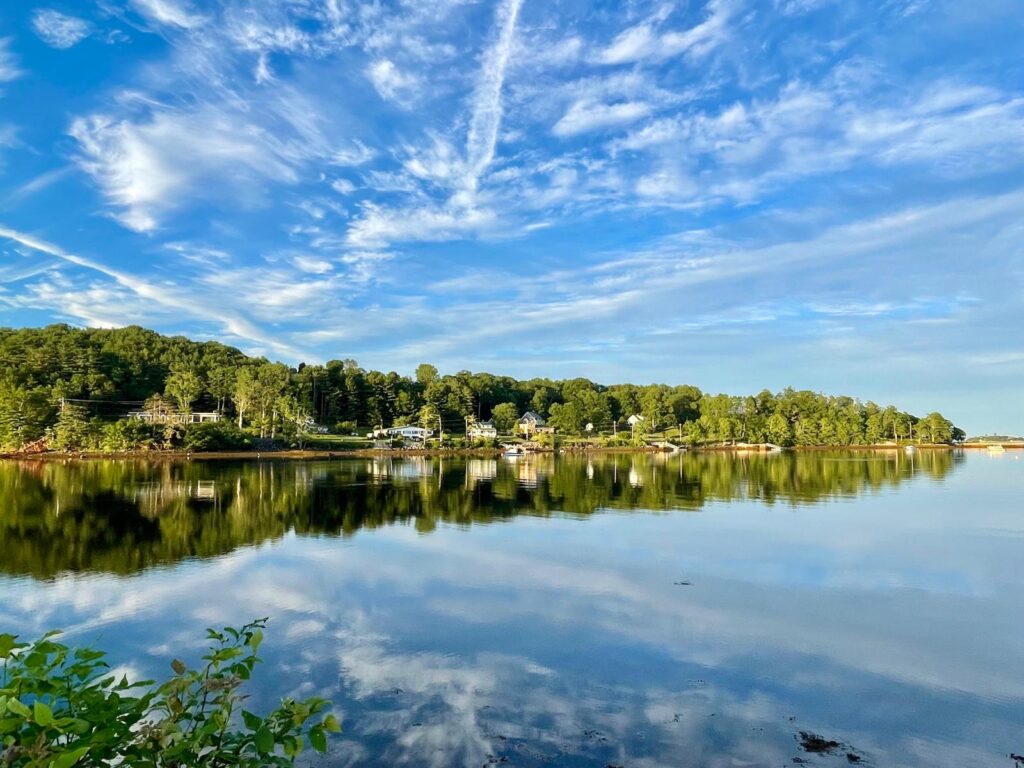
We spent the following morning exploring the small town of Mahone. Some started with coffees at the local café as they watched the residents go about their daily lives; others went for walks and runs, pootled around the shops, and sat at the infamous three churches. Ready to get back out on the water again, the navigators of the day briefed the crew with the plan of action, which involved a complex section of pilotage. The waters between Mahone Bay and Chester were testing. Still, with careful precision, we could navigate through what felt like a Nova Scotian backyard with stunning green forestry and all the luscious smells that go with it. With only a short sail and the wind on the nose, we decided it was an excellent time to practice tacking. The crew rotated positions around the cockpit as we tacked our way around the islands. “Ready about, helm to lee, lee ho!”. With each tack, the manoeuvres got slicker, and we longed for someone to race against, but sadly, there were no volunteers. After picking out the houses we would reside in, had we had the money, we lowered our sails and anchored in the Chester basin. A home away from home for me, a Cestrian.
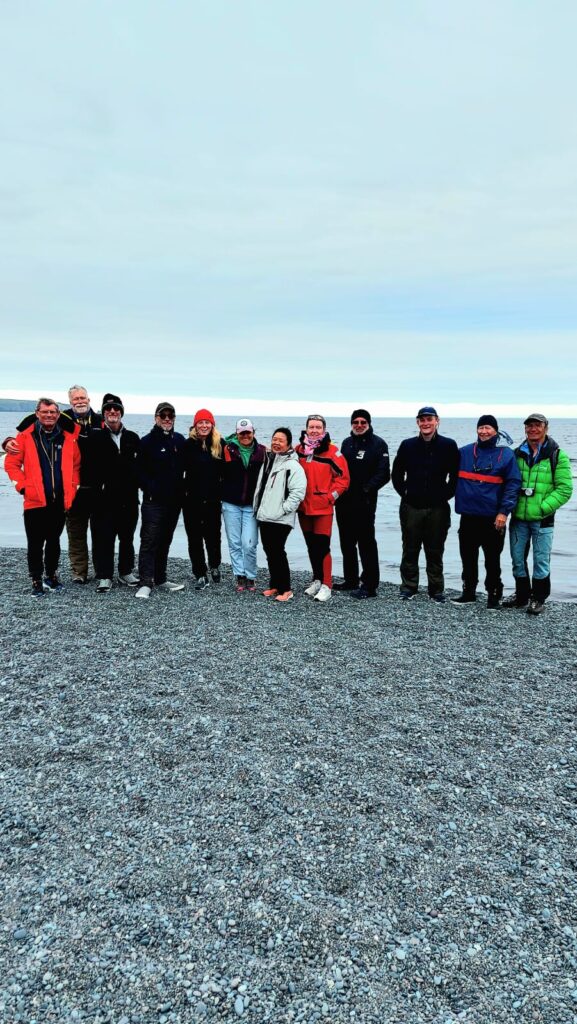
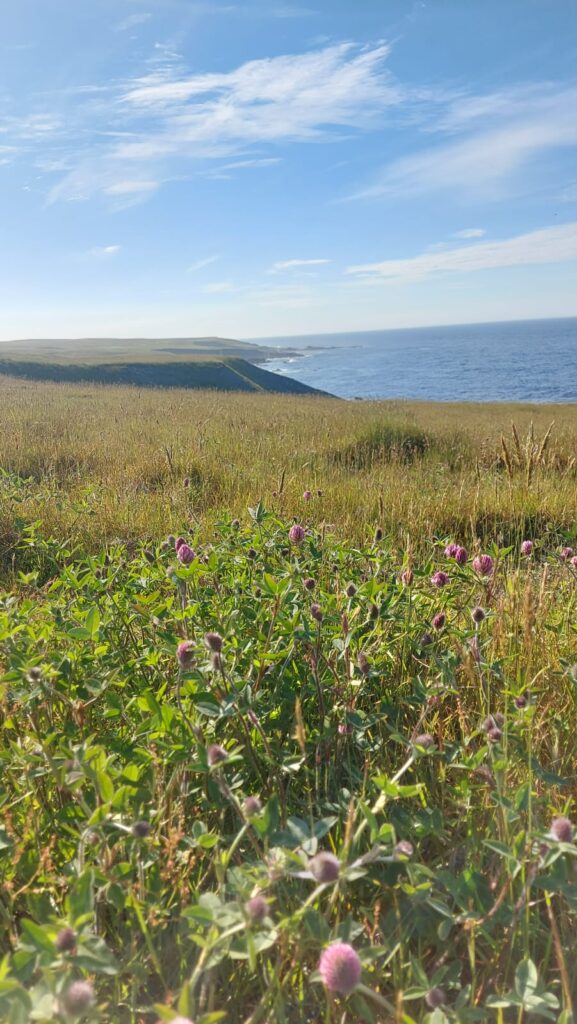
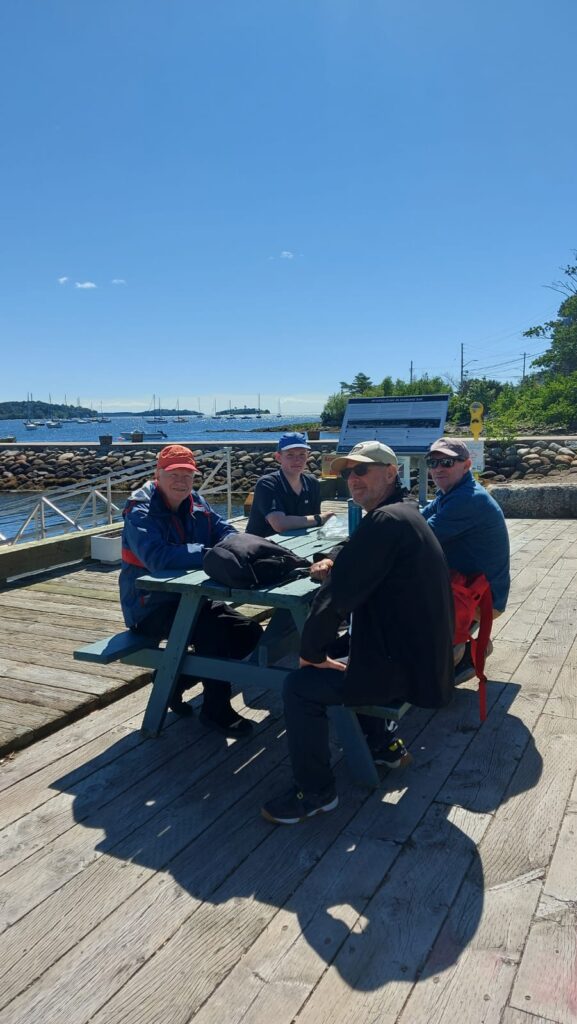
As Saturday came about, with the forecast set to dwindle, we raised the main sail at anchor. We proceeded to motor sail to our next destination, Halifax. Halifax would be our last stop in Nova Scotia, or so we thought, before crossing over to Newfoundland. After meandering up the northwest arm towards Melville’s Island, being sure to dodge the dinghy, waterskiers and powerboaters, we berthed on the fuel pontoon for the evening. It took a lot of work to find, with very few helpful hints from the sullen young lad who operated the marina’s VHF. Once the boat was put to bed, the crew dispersed for the evening, some catching the bus to town while the rest settled into the local Armdale Yacht Club. We started the evening by sampling the local beers on the yacht club roof terrace. As the rest of the crew arrived in dribs and drabs from the one shower in town, we began exploring the local menu from top to bottom.
Aiming to leave Halifax around midday on Sunday, we had a few jobs to get done beforehand – rig checks, provisioning, filling fuel and water tanks and settling the bill with the not-so-forthcoming
marina boy. Once Marie, our French compatriot, sprung us off the pontoon, we headed back down the river, this time bound for Newfoundland. The pleasant south-westerly breeze allowed us to sail with a full main and Yankee one well into the evening, cruising along on a broad reach around eight knots. Unfortunately, this part of the trip also took hostage to some seasick crew, although all bounced back come the morning when the wind had died off and subsequently the sea state. As the wind died off, we downloaded an up-to-date forecast and changed the plans so the crew could get a good night’s rest and make the most of the upcoming winds. Altering course to Louisbourg on the northeast tip of Nova Scotia, we were set to arrive later that evening. As the sun began to set, the sky transformed into a flurry of pink shades, with the lateral markers forming a shadow on the horizon. Equipped with a belly full of apple crumble and custard, a dish I had been craving since leaving the Bahamas, we executed what could be considered a textbook piece of nighttime pilotage. Entering the small channel into Louisbourg using the port and starboard markers, we followed the leading lights, which took us down to our next turning point, a west cardinal marker in transit with a port hand marker. We dropped anchor around ten that evening, all longing for a peaceful night’s rest as we listened to the rain patter on the hatches above our heads.
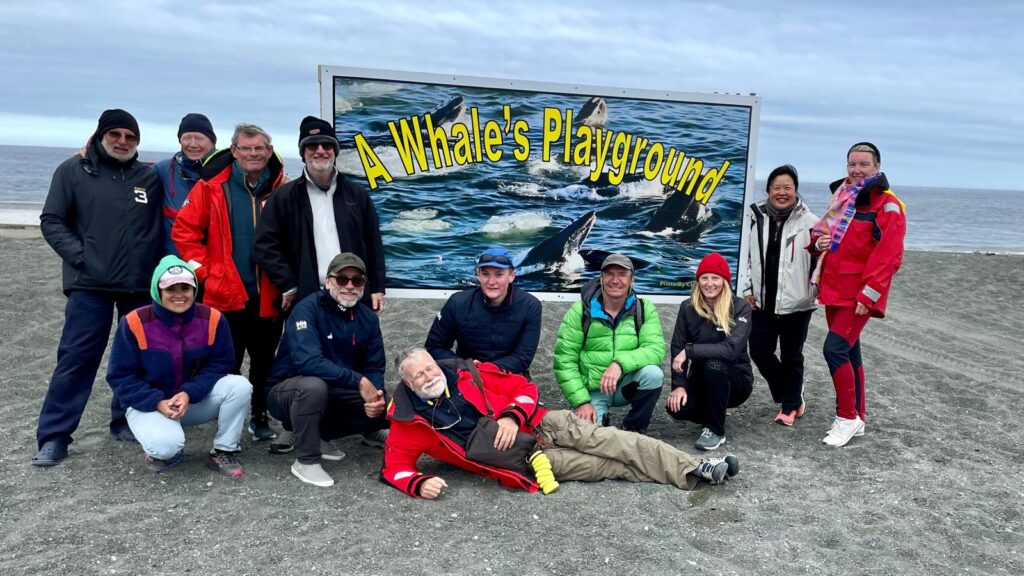
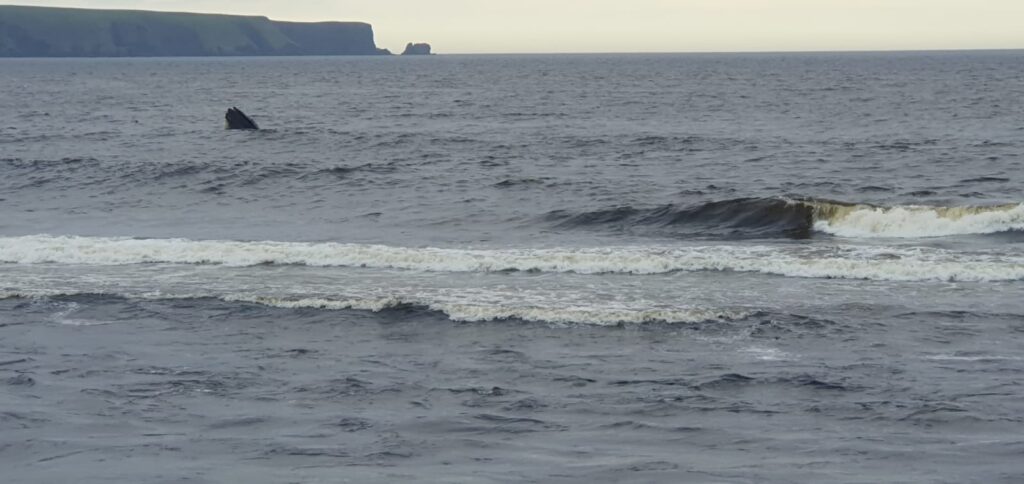
Blog 2 From Nantucket to Mahone Bay, Nova Scotia
The three-day crossing from Nantucket to Nova Scotia allowed little time, or more importantly, much of a stable surface, for reclining in the nav station to ponder my thoughts. So here I sit again, this time the fog has lifted, the sun is shining, and I have a belly full of insipid broth, purchased by myself, under the impression it was a thick and flavoursome winter vegetable soup that the crew would devour on a cold day on deck. Bless them for being so gracious and eating it anyway – most of them, that is.
I finished the last blog entering a blanket of thick fog after having just left Nantucket – our last stop in the States. True to its form, the east coast of Nova Scotia did not fail to deliver an abundance of wildlife, poor visibility, and high winds. 20nm northeast of Nantucket, and we could not see more than one hundred metres off the bow. The crew on watch used everything within their means to keep us navigating safely – radar, foghorns, AIS, VHF, and extra eyes and ears on deck. Every sound coming out of the plumes of fog and every target on the radar was scrutinised to find meaning. On the bright side of all the attentiveness on deck, we were able to spot wildlife that we may have otherwise missed: a shark and several whales within metres of the boat, hopefully just the tip of the iceberg of Canadian wildlife. As the evening went on, we settled into our watch systems, three hours on and six hours off.
The wind picked up on the second day of our voyage across the Gulf of Maine, as anticipated from our last downloaded forecast and with the sea state and weather helm increasing, the crew assembled on deck to downsize the canvas, reefing in the main and switching out the Yankee two for the staysail. As the boat steadied, although still in a two-metre sea state, Roger kept us on track while the crew could take a breather and enjoy a well-deserved cup of tea. Making tea onboard Bluejay over the past two weeks has been somewhat of a learning curve, primarily for our American compatriots, and a great source of entertainment for myself, but once I caught one crew member putting teabags straight in the kettle to boil, I knew action had to be taken. However, the ongoing debate of how many teabags go into the teapot remains to be settled.
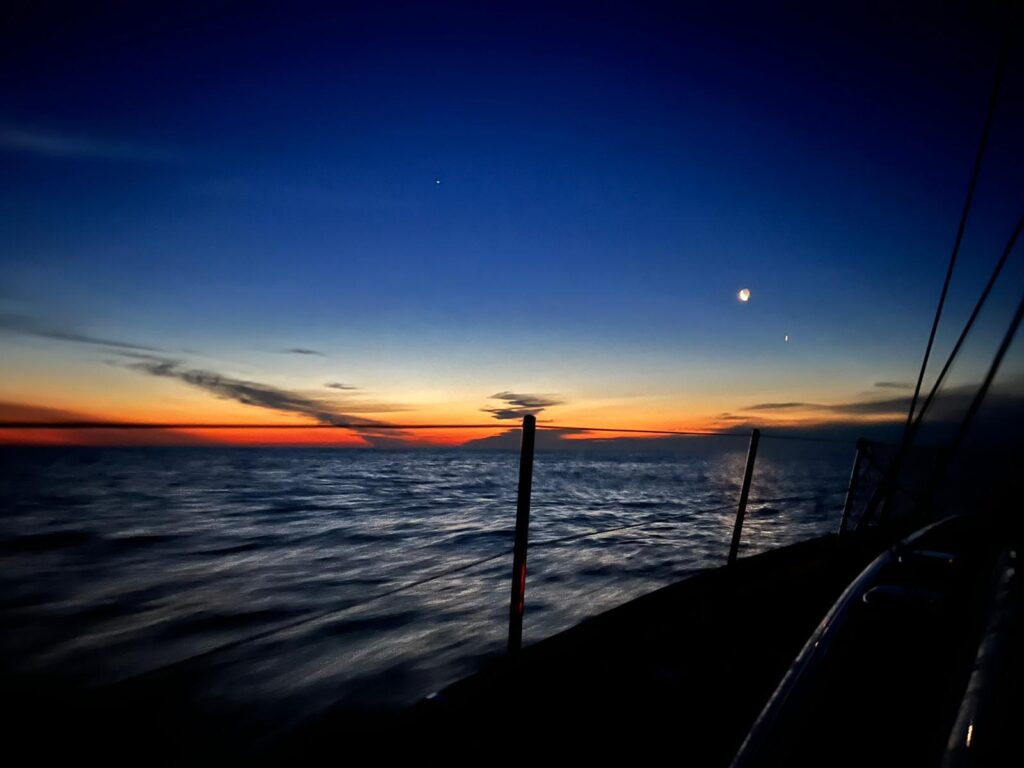
Later that afternoon, I set up the sat phone to download the latest Grib file sent from our shore contact back in the UK. With the weather forecast set to continue with gusts of up to thirty-seven knots, we decided to stick to our current sail plan of a fully reefed main and staysail. The relentless fog remained as the next and final day of our crossing to Nova Scotia came about. Still, the high winds were replaced with heavy sideways rain this time. With the radar now full of walls of rain passing over us, the crew dwindled to just four on deck, with the occasional person down below hollering through the companionway hatch for tea and coffee orders for the deck and to double-check that it was, in fact, still raining – I think this is a British thing. About 60nm from our original destination, Lunenberg, we decided to make the call to anchor for the evening in Liverpool, just 35nm south. Albeit tired and mostly damp, spirits were still high as we dropped anchor in Liverpool Bay. Once the heating was on, dinner was squared away, and Stewart’s guitar was out, the crew huddled in the cosy saloon to sing the well-loved Debs a Happy Birthday. As with most aspects of boat life, improvisation was necessary for the cake – a home-cooked brownie topped with orange segments and Reese’s peanut butter cups. I think she appreciated the uniqueness. A few shanties and sing-a-longs later, we headed to bed, all enjoying the tranquillity of the water beneath us.
The following morning, we weighed anchor and headed for Lunenburg, where we would spend a couple of days soaking up the history of this small town, as well as showering and doing laundry, of course. As we moored Bluejay alongside the visitor’s pontoon, the locals reclining in their brightly coloured deck chairs along the quay gave us the once-over. We could tell instantly that our 60-foot Bluejay and the crew inside her would be the talk of the town.
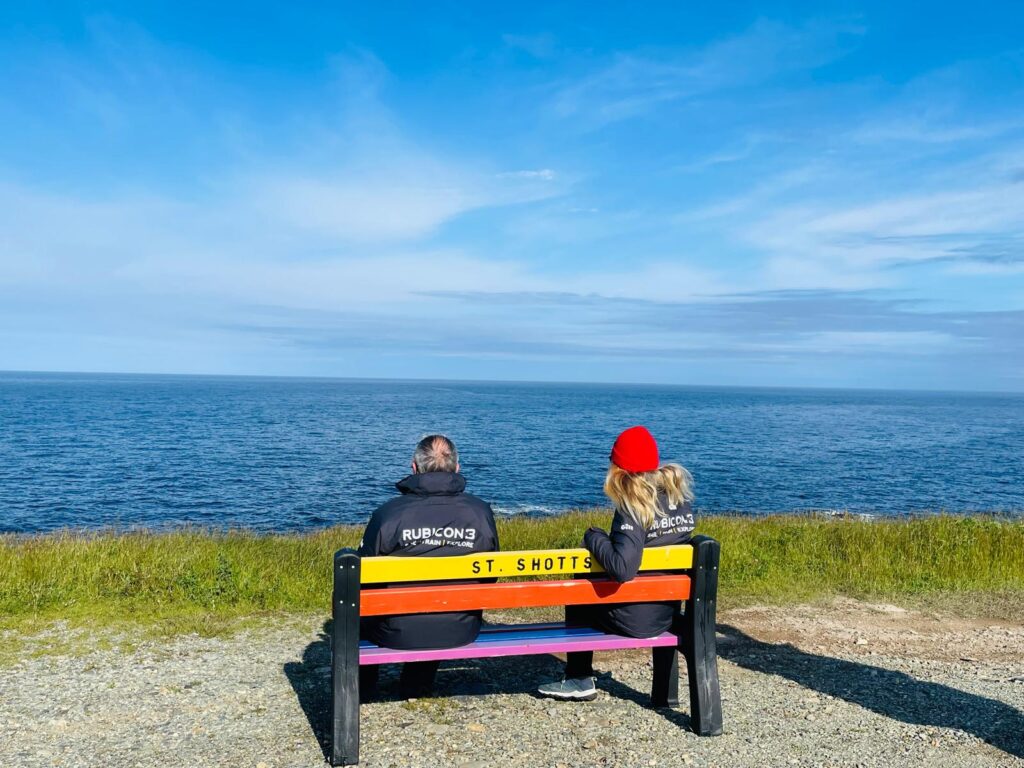
The following two days, we were welcomed with open arms by the Lunenburg locals. From the moment we cleared into the country with the customs officers, to the lift from the local fisherman to the petrol station to fill up our 250 litres of jerry cans, to having our groceries driven back to the boat, we were never short of a helping hand in this charming town. For us to learn more about the rich history behind this town and how it came to be a UNESCO World Heritage Site, our social sec, Matt, organised a fabulous walking tour. We learnt about the first settlements in Lunenburg and how they went from farming to fishing to famous shipbuilders responsible for the infamous Bluenose and now Bluenose II, which still tours the harbour today.
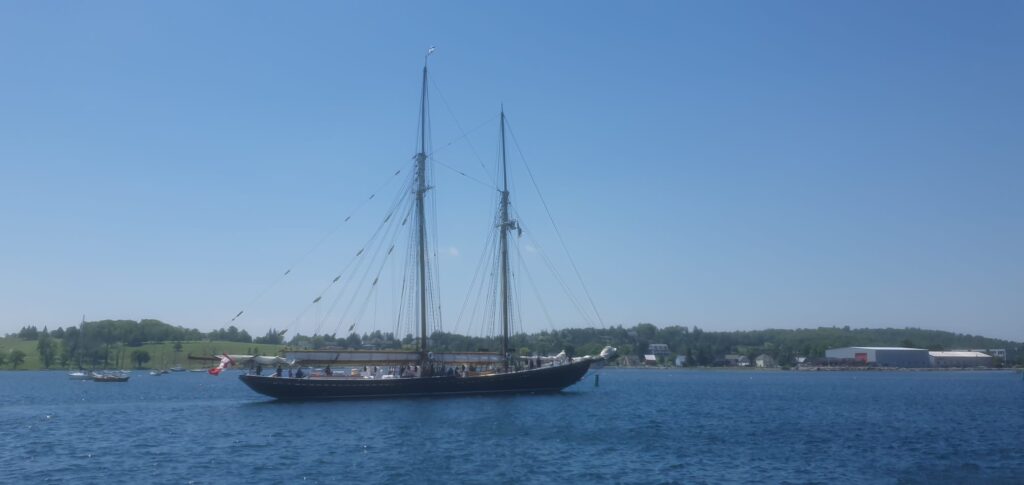
The following morning was quite a contrast to the day before, with fog and rain from the offset; we decided to put off our departure until the afternoon. After several recommendations from locals and other sailors, we set our hearts on the beautiful Mahone Bay, just 20nm north. By the time we finished our last bits of provisioning, souvenir buying and postcard sending, the fog had cleared. Although the air was still crisp, we were making the most of our newfound visibility at sea. After four hours weaving through the islands and shallows up the coast, we landed in Mahone Bay – the home of the three churches. Like clockwork, the crew quickly assembled to put the boat to bed to relax and enjoy the beautiful evening ahead. Sitting in the cockpit as the sun slowly dropped behind the horizon, we feasted on the home-cooked meal before us. Feeling bad that there was no bottle of red to go with the meal, something the crew had longed for since the onions were sautéed in the pan, I did my best to offer a solution. Finding a miniature bottle of Merlot, probably left over from my last long-haul flight, we passed it around the cockpit, each taking a sip, savouring the taste. We later found out there was a bar a two-minute rib ride away from the boat. However, there was something slightly more romantic about our evening onboard.
Blog 1: From New York City to Liverpool, Nova Scotia
After almost two weeks exploring the bright lights of New York City, Bluejay was ready to cast her lines and set sail on her biggest adventure of the year—a six-week expedition up the Eastern Seaboard, onward to Nova Scotia, Newfoundland and, ultimately, Scotland. As I sit here in the nav station, listening to the sound of the fog horn and the clanking of pans as the morning’s porridge is being so lovingly prepared, I have time to reflect on the past ten days since waving goodbye to the impressive Manhattan skyline.
Day one saw the arrival of our eclectic crew – a mix of American, French, Swiss, Canadian, Australian, Brazilian and British. I have always loved to have a crew of mixed backgrounds onboard. Not only can we learn more about different cultures and ways of life, but, most importantly, it keeps the galley alive with recipes from around the world. After starting with introductions, both to the boat and each other, we were ready to slip lines and meander up the East River towards Long Island Sound. Although we could not sail due to our confined waters and immense traffic, we enjoyed what felt like a riverboat cruise through the boroughs of New York. The sun shone in a bright blue sky as we picked out famous landmarks – the Statue of Liberty, Brooklyn Bridge and the Empire State Building, to name a few. We ended our day by dropping anchor in Oyster Bay, a mere 35nm from the city, where the evening chefs became acquainted with the galley.
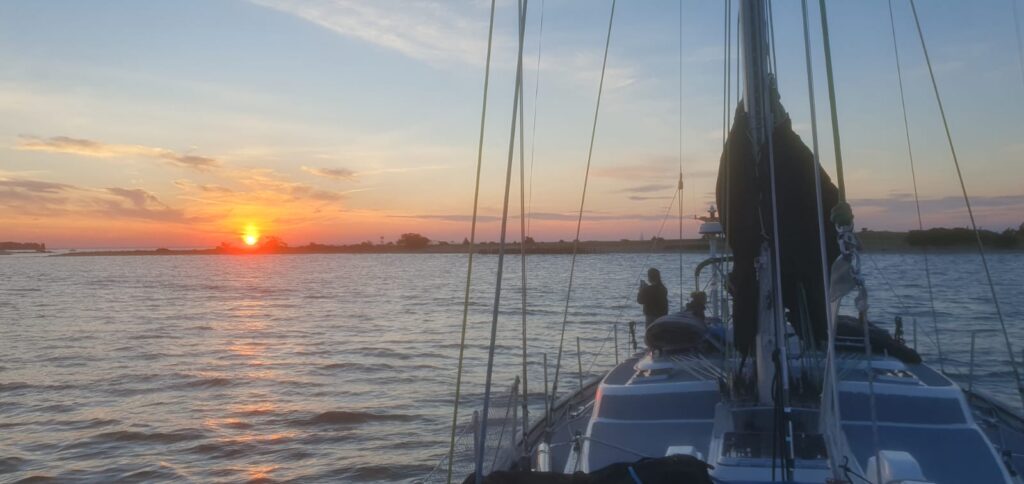
We made the most of the open water and light breeze. The next few days saw us raising sails, tacking, gybing and practising MOB drills as we made our way up Long Island Sound, stopping at Jefferson Harbour and Montauk for a well-deserved rest each evening. As we watched the luminous orange sunset from our cockpit in Fort Pond, Montauk, the evening’s discussion led to our route plan for the next week. With so much to explore in New England and a three-day crossing to Nova Scotia on the cards, we settled on Newport, Martha’s Vineyard, and two days in Nantucket before crossing over to Lunenburg, Nova Scotia. After putting the charts, passage plan books, and weather apps to bed, we ended the evening with our onboard musician, Stewart, who sang and played his travel guitar. We enjoyed the Swiss chocolate kindly provided by Roland, our Swiss crewmate.
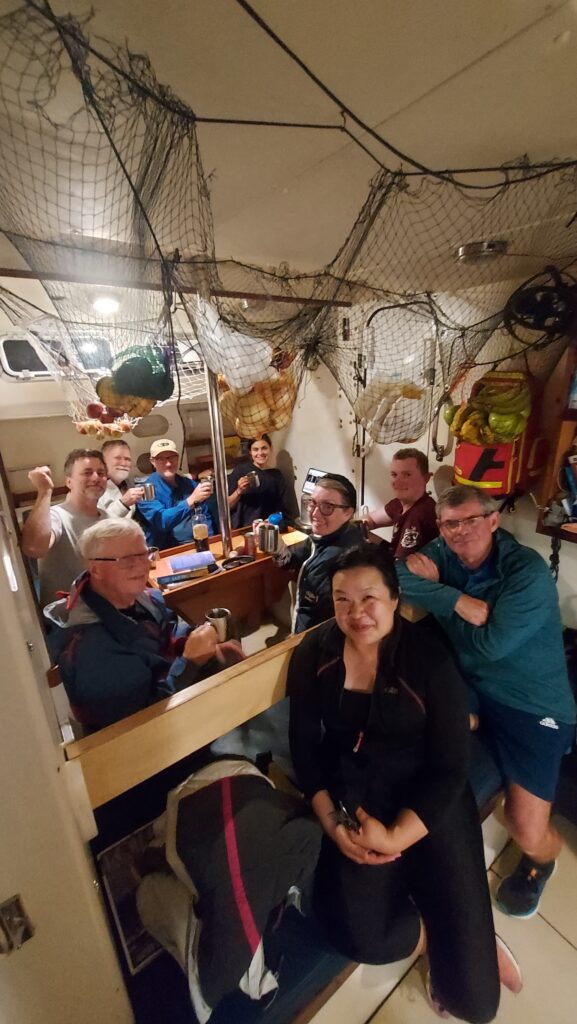
The following morning, we enjoyed the pleasant south-westerly wind, rigged with one reef in the main and a Yankee two headsail, giving us a chance to practise our downwind sailing. Taking turns helming, rigging preventers and gybing, we are slowly becoming a well-oiled machine, all in anticipation of our two-week offshore passage where all we will have is each other and our trusty Bluejay to keep us safe. That evening, we arrived in Newport, Rhode Island – the home of the infamous America’s Cup. We inflated the rib and headed ashore for beers, ice cream and showers – in that order for most. The small streets of Newport were lined with bars, restaurants, galleries, and charming souvenir shops, all of which we indulged after being afloat for four days.
Our exploration of New England continued the following day with a 45nm sail east towards Vineyard Sound and Martha’s Vineyard Haven Harbour. After deciding to dine onboard and explore the island over a lavish American breakfast in the morning, the crew hit the hay early. The following morning, our resident Canadian and early morning riser, Bill, woke the crew with the smell of hot coffee funnelling through the boat. It took little time ashore in Martha’s Vineyard to understand why it’s such a popular holiday spot for many Americans. With their air of a laidback yet wealthy vibe, the streets had one of our crew mates describing the island as “aggressively quaint”.
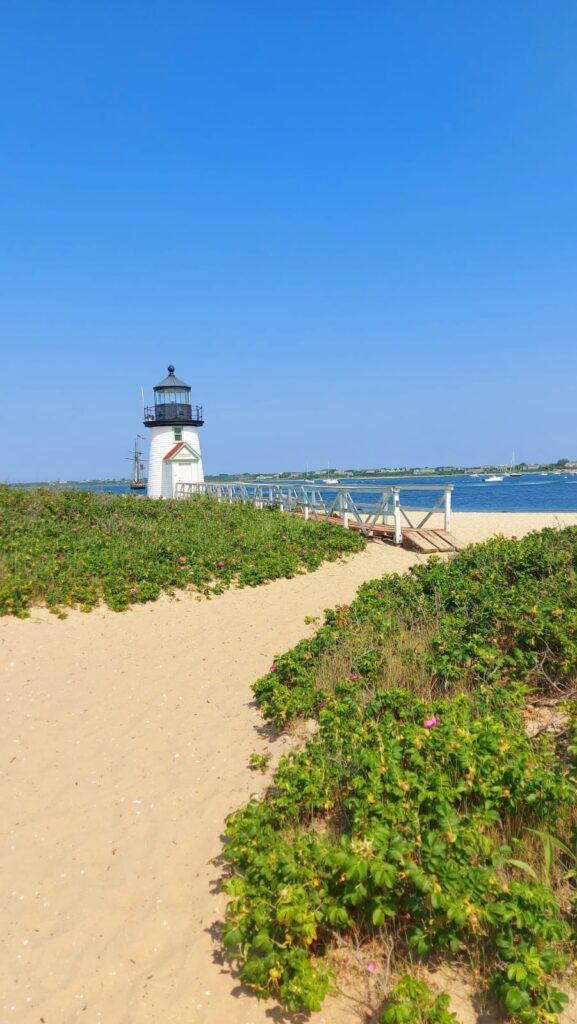
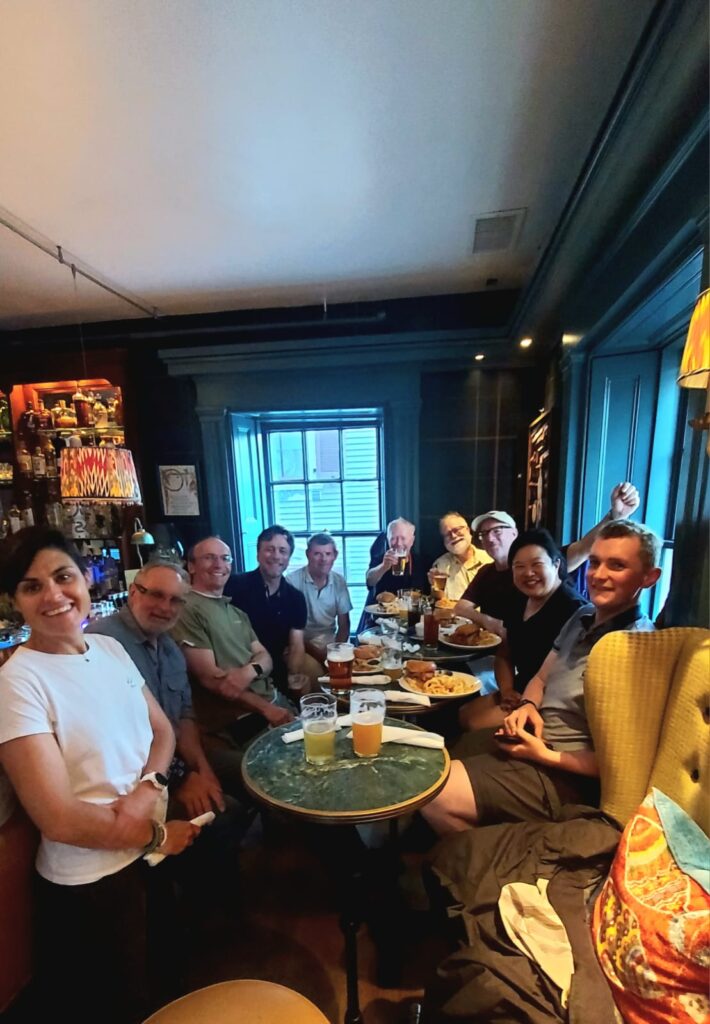
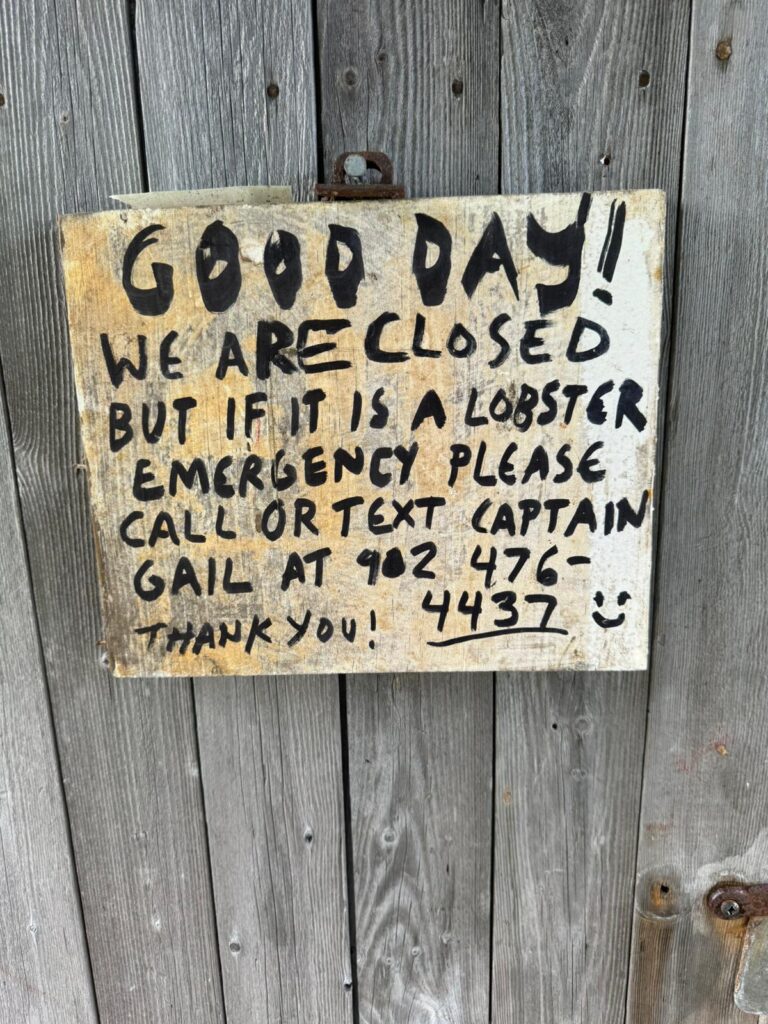
Keeping an eye on the weather for our crossing to Canada, we decided to make the leap across the Gulf of Maine to Nova Scotia on Saturday morning, giving us two days to explore Nantucket and prepare the boat. A short sail of 30nm saw us depart Martha’s Vineyard and head east towards Nantucket. Again, blessed with significant winds, we made good time and entered what seemed like a minefield of mooring buoys in Nantucket harbour, the only instruction from the harbour master being ‘head towards the boat basin and find G5 mooring buoy’. We had all eyes on deck, meticulously sieving through and reading the name of each buoy, all while keeping an eye out for the opulent and well-polished boats that surrounded us as we navigated the tiny channels. After finally tying up to the elusive G5 mooring buoy, we prepared for an evening ashore. At this point, those wearing finery, long trousers and a clean t-shirt opted for the harbour launch to pick them up; those less fortunate or, maybe caring less, opted for a primarily dry rib ride from myself. After some research by our newly designated social sec, Matt, we dined as a crew at the Brotherhood of Thieves restaurant. Unable to book a table for twelve people, we squished into the corner of the bar. After the waitress stopped apologising for the lack of space, we probably should have mentioned our usual dining quarters are a third of the size. As Friday rolled around, there were plans to explore all Nantucket had to offer, and it offers so much. Trips to the whaling museum, bike rides to Brant Point and Sankaty lighthouse, walks along the bluffs, relaxing on Cisco beach, perusing the many shops, and absorbing the history of this picturesque and unique island.
All well-rested and legs stretched, we had to leave G5 and Nantucket behind. After final provisioning and boat checks, we headed out of the harbour with Roger, our day’s navigator, guiding us out of the shallows around the island’s northeast and into the Gulf of Maine – bound for Canada! The winds were light, the sea was flat and the visibility perfect. However, these favourable conditions did not last long. The warm water of the Gulf Stream penetrating the cooler high latitudes often produces a blanket of fog, and this occasion was no exception. A mere 20nm into our 340nm voyage, visibility was less than one hundred metres off the bow. With radar on, fog horns at the ready and binoculars out, we sailed our way through the channel, hopping from buoy to buoy and through the TTS until we were able to get on our course, which we would hold for the next three days – 060°.
